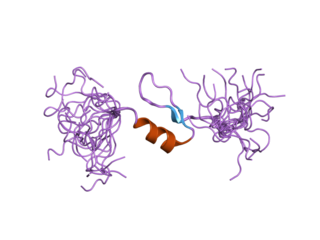
Transcription factor Sp1, also known as specificity protein 1* is a protein that in humans is encoded by the SP1 gene.
The mSin3 interaction domain (SID) is an interaction domain which is present on several transcriptional repressor proteins including TGFβ and Mad. It interacts with the paired amphipathic alpha-helix 2 (PAH2) domain of mSin3, a transcriptional repressor domain that is attached to transcription repressor proteins such as the mSin3A corepressor.
In molecular genetics, the Krüppel-like family of transcription factors (KLFs) are a set of eukaryotic C2H2 zinc finger DNA-binding proteins that regulate gene expression. This family has been expanded to also include the Sp transcription factor and related proteins, forming the Sp/KLF family.

Krüppel is a gap gene in Drosophila melanogaster, located on the 2R chromosome, which encodes a zinc finger C2H2 transcription factor. Gap genes work together to establish the anterior-posterior segment patterning of the insect through regulation of the transcription factor encoding pair rule genes. These genes in turn regulate segment polarity genes. Krüppel means "cripple" in German, named for the crippled appearance of mutant larvae, who have failed to develop proper thoracic and anterior segments in the abdominal region. Mutants can also have abdominal mirror duplications.

Paired amphipathic helix protein Sin3a is a protein that in humans is encoded by the SIN3A gene.

PDX1, also known as insulin promoter factor 1, is a transcription factor in the ParaHox gene cluster. In vertebrates, Pdx1 is necessary for pancreatic development, including β-cell maturation, and duodenal differentiation. In humans this protein is encoded by the PDX1 gene, which was formerly known as IPF1. The gene was originally identified in the clawed frog Xenopus laevis and is present widely across the evolutionary diversity of bilaterian animals, although it has been lost in evolution in arthropods and nematodes. Despite the gene name being Pdx1, there is no Pdx2 gene in most animals; single-copy Pdx1 orthologs have been identified in all mammals. Coelacanth and cartilaginous fish are, so far, the only vertebrates shown to have two Pdx genes, Pdx1 and Pdx2.

Krueppel-like factor 6 is a protein that in humans is encoded by the KLF6 gene.

Tripartite motif-containing 28 (TRIM28), also known as transcriptional intermediary factor 1β (TIF1β) and KAP1, is a protein that in humans is encoded by the TRIM28 gene.

Kruppel-like factor 4 is a member of the KLF family of zinc finger transcription factors, which belongs to the relatively large family of SP1-like transcription factors. KLF4 is involved in the regulation of proliferation, differentiation, apoptosis and somatic cell reprogramming. Evidence also suggests that KLF4 is a tumor suppressor in certain cancers, including colorectal cancer. It has three C2H2-zinc fingers at its carboxyl terminus that are closely related to another KLF, KLF2. It has two nuclear localization sequences that signals it to localize to the nucleus. In embryonic stem cells (ESCs), KLF4 has been demonstrated to be a good indicator of stem-like capacity. It is suggested that the same is true in mesenchymal stem cells (MSCs).

C-terminal-binding protein 1 also known as CtBP1 is a protein that in humans is encoded by the CTBP1 gene. CtBP1 is one of two CtBP proteins, the other protein being CtBP2.

Krueppel-like factor 5 is a protein that in humans is encoded by the KLF5 gene.

Krüppel-like Factor 2 (KLF2), also known as lung Krüppel-like Factor (LKLF), is a protein that in humans is encoded by the KLF2 gene on chromosome 19. It is in the Krüppel-like factor family of zinc finger transcription factors, and it has been implicated in a variety of biochemical processes in the human body, including lung development, embryonic erythropoiesis, epithelial integrity, T-cell viability, and adipogenesis.

Krueppel-like factor 10 is a protein that in humans is encoded by the KLF10 gene.

Kruppel-like factor 13, also known as KLF13, is a protein that in humans is encoded by the KLF13 gene.

Krueppel-like factor 8 is a protein that in humans is encoded by the KLF8 gene. KLF8 belongs to the family of KLF protein. KLF8 is activated by KLF1 along with KLF3 while KLF3 represses KLF8.

Krüppel-like factor 3 is a protein that in humans is encoded by the KLF3 gene.

Kruppel-like factor 7 (ubiquitous), also known as KLF7, is a protein which in humans is encoded by the KLF7 gene.

Krüppel-like factor 14, also known as basic transcription element-binding protein 5 (BTEB5) is a protein that in humans is encoded by the KLF14 gene. The corresponding Klf14 mouse gene is known as Sp6.

Krüppel-like factor 15 is a protein that in humans is encoded by the KLF15 gene in the Krüppel-like factor family. Its former designation KKLF stands for kidney-enriched Krüppel-like factor.

Kruppel like factor 16 is a protein that in humans is encoded by the KLF16 gene.





















